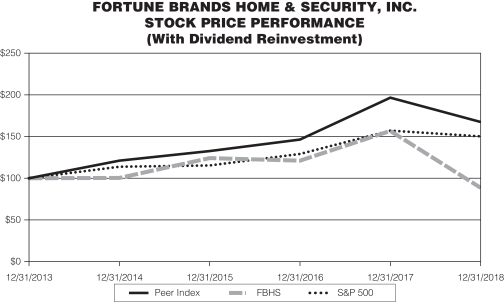The Tax Act included a provision for Global IntangibleLow-Taxed Income (GILTI), the Company elected an accounting policy to treat GILTI as a period cost when incurred. The GILTI provision is effective for taxable years of foreign corporations beginning after December 31, 2017.
Revenue Recognition The Company recognizes revenue for the sale of goods based on its assessment of when control transfers to our customers. Refer to Note 14 for additional information.
Cost of Products Sold Cost of products sold includes all costs to make products saleable, such as labor costs, inbound freight, purchasing and receiving costs, inspection costs and internal transfer costs. In addition, all depreciation expense associated with assets used to manufacture products and make them saleable is included in cost of products sold.
Customer Program Costs Customer programs and incentives are a common practice in our businesses. Our businesses incur customer program costs to obtain favorable product placement, to promote sales of products and to maintain competitive pricing. We record estimates to reduce revenue for customer programs and incentives, which are considered variable consideration, and include price discounts, volume-based incentives, promotions and cooperative advertising when revenue is recognized in order to determine the amount of consideration the Company will ultimately be entitled to receive. These estimates are based on historical and projected experience for each type of customer. In addition, for certain customer program incentives, we receive an identifiable benefit (goods or services) in exchange for the consideration given and record the associated expenditure in selling, general and administrative expenses. Volume allowances are accrued based on management’s estimates of customer volume achievement and other factors incorporated into customer agreements, such as new product purchases, store sell-through, merchandising support, levels of returns and customer training. Management periodically reviews accruals for these rebates and allowances, and adjusts accruals when circumstances indicate (typically as a result of a change in volume expectations). The costs typically recognized in selling, general and administrative expenses include product displays, point of sale materials and media production costs. The costs included in the selling, general and administrative expenses category were $66.5 million, $62.4 million and $44.1 million for the years ended December 31, 2018, 2017 and 2016, respectively.
Selling, General and Administrative Expenses Selling, general and administrative expenses include advertising costs; marketing costs; selling costs, including commissions; research and development costs; shipping and handling costs, including warehousing costs; and general and administrative expenses. Shipping and handling costs included in selling, general and administrative expenses were $215.9 million, $204.7 million and $197.0 million in 2018, 2017 and 2016, respectively.
Advertising costs, which amounted to $243.6 million, $233.2 million and $199.1 million in 2018, 2017 and 2016, respectively, are principally expensed as incurred. Advertising costs paid to customers as pricing rebates include product displays, marketing administration costs, media production costs and point of sale materials. Advertising costs recorded as a reduction to net sales, primarily cooperative advertising, were $72.4 million, $65.6 million and $52.5 million in 2018, 2017 and 2016, respectively. Advertising costs recorded in selling, general and administrative expenses were $171.2 million, $167.6 million and $146.6 million in 2018, 2017 and 2016, respectively.
Research and development expenses include product development, product improvement, product engineering and process improvement costs. Research and development expenses, which were $50.3 million, $50.7 million and $53.1 million in 2018, 2017 and 2016, respectively, are expensed as incurred.
Stock-based Compensation Stock-based compensation expense, measured as the fair value of an award on the date of grant, is recognized in the financial statements over the period that an employee is required to provide services in exchange for the award. The fair value of each option award is measured on the date of grant using the Black-Scholes option-pricing model. The fair value of each performance share
50
